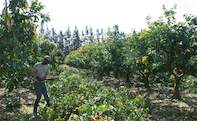
One of the key functions of RegenAG is to raise awareness of the negative impact of industrial agriculture and the way in which regenerative agriculture can help to address these issues.
The biggest problems with industrial agriculture is that farmers are heavily dependent on tillage, chemical fertilisers, pesticides and herbicides.
These inputs not only have a detrimental impact on the environment, soil and people’s health, but farmers over time get caught up in a destructive spiral where they need to apply more and more inputs in an attempt to sustain production volumes while their soils degrade.
As the cost of production increases, the profitability of farming decreases as farmers are price-takers. They in effect have to acquire more and more land in an attempt to make ends meet. One of our biggest challenges in food security is the massive debt that farmers carry.
Regenerative agriculture addresses this situation by using a combination of practices that helps to reduce farmers’ reliance on tillage and chemical inputs. There are no quick fixes or recipes for success, as the farming approach recognises that each production system is different and continuously evolving.
It is more environmentally friendly, resulting in farmers and their workers being less exposed to chemicals. In a few years, soil life returns, halting soil loss, nourishing plants, reducing the need for fertilisers and increasing the water holding capacity of the soil.
As carbon is pumped back into the soil, where it used to be before agriculture put it into the atmosphere, the water cycle and nutrient cycles are restored. Carbon is the currency of regenerative agriculture, inorganic nitrogen, with its massive carbon footprint it is the currency of industrial agriculture, according to Andrew.
Consumers in turn benefit from healthier food, as food produced in healthy soils are generally more nutrient dense and wholesome than food produced in a system where only the bare needs of the plants are addressed. As such, regenerative agriculture has a huge potential in addressing hunger and malnutrition.
The environmental footprint of this farming system is also low, resulting in reduced chemical run-off, degraded soils being restored, lower carbon emissions and less water and environmental pollution.
The system, as such, is much more resilient than industrial production systems, as the improved soil structures and healthy plants are better able to cope with environmental stressors, such as pests, insects, heatwaves, floods and droughts.
Besides this, the regenerative agricultural system is more ecologically friendly, as farmers aim to create a natural equilibrium, where beneficial, parasitic and predatory insects keep populations of crop damaging insects and diseases in check.
 South Africa’s agricultural sector is one of the world’s most diverse, consisting of corporate and private intensive and extensive crop ...
South Africa’s agricultural sector is one of the world’s most diverse, consisting of corporate and private intensive and extensive crop ...